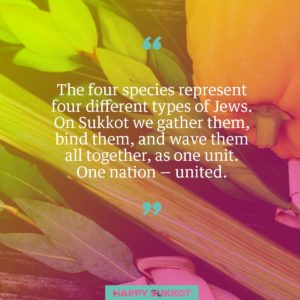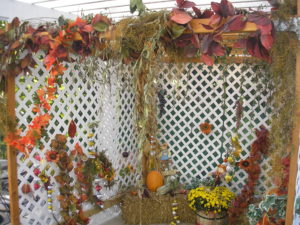Sukkot: What We Learn When Our Walls Come Down
When Yom Kippur ends, another Jewish holiday begins. Sukkot! This week-long pilgrimage festival (October 5-13, 2017) commemorates the time when Israelites wandered the desert for 40 years after escaping from slavery in Egypt. The Jewish people built temporary tent-like structures to sleep, eat, and dwell in, and it’s a mitzvah for us to build a sukkah and to immerse ourselves in nature and God’s presence. At this time in our world, when everyday seems to bring another natural or manmade tragedy, from the hurricanes to mass shootings, we are reminded of how vulnerable we really are. The safety of four concrete walls can’t protect us from harm. Also, when we isolate ourselves in our shelters, we can’t connect with each other. So, Sukkot is a time for our walls to come down, for us to be in touch with not only nature and with God, but also with each other. During Sukkot, we are reminded that God’s presence is bigger than all of us. Sukkot, yet another opportunity to make the ordinary–like an outdoor hut–holy again.
Sukkot is a joyful holiday—we eat, sleep, and socialize with guests (ushpizin) in our makeshift booth. Building and decorating a skukkah is a fun activity to share with family, friends and neighbors. Traditionally, the sukkah must be at least 27 x 27 square foot and have at least three walls. The walls can be of any material, as long as they are sturdy enough to withstand a normal wind.
The roof material (S’chach) must be made from a product of trees, such as branches, leaves or bamboo, anything natural that provides shade and yet allows the light of the sun and moon to shine through. This idea reminds us to be closer to nature, to the universe, and that God is bigger than all of us.
Decorating the sukkah is part of the fun, too! When the kids were younger, we hung fruits, flowers, gourds, small pumpkins, and paper chains from the ceiling. Some people hang posters and pictures with Jewish themes on the walls as well, anything to make the sukkah feel cozy and homey.
During Sukkot, we also wave the Four Species that represents all different types of Jews (and people) coming together:
- Esrog – the citron, a fragrant fruit with a thick, white rind that ripens to look like a big yellow lemon.
- Lulav – the palm branch, which has a straight shape and leaves tightly bound.
- Hadas – the myrtle branch, which has three leaves coming out from the same point in the branch.
- Arava – the willow branch, which should have oblong leaves with a smooth edge.
We bind these three branches together and shake them in all directions (north, south, east and west) to recognize God’s presence all around us. We hold the esrog and species in our hands and say the Shechiyanu.
“Baruch atah Adonai, Eloheynu Melech Ha Olam, shechiyanu v’kimanu, v’higianu, lazman ha ze.” (Blessed are You Adonai our God, Ruler of the Universe, who has given us life, sustained us, and enabled us to reach this moment.)
Try these new recipes for Sukkot, using favorite ingredients of the fall season: https://www.joyofkosher.com/2017/09/12-stuffed-foods-for-sukkot/
Here’s a video on how to build a Sukkah: https://www.myjewishlearning.com/article/the-sukkah/


